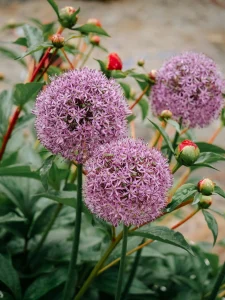
This Year Cibus Mission’s Youth Urban Farm Program will be growing Onions!
Why Onions?
“Isn’t it a beautiful flower, Princess? It’s your favorite color—purple!”
“Yes, Daddy! What is it?”
“I… don’t know. But I’ll ask.”
This was the conversation I was witness to between a young father and his four-year-old daughter, dressed in lavender from her ribbons to her twirling skirt. The Father pointed at an onion bloom—a humble plant he couldn’t name.
My heart broke. Not for him, but for all of us.
How can we love fresh food if we don’t even recognize it? How can we pass down what we’ve forgotten? Generations of farming knowledge are vanishing, leaving parents and children disconnected from the very roots of their meals.
I was there in that moment and was able to pull it from the ground and let them touch the plant, smell and peel the layer from the purple onion hiding below the stem of the Purple Flower.
We need more of these moments! More dirt under fingernails, more 'aha!' moments, more hands learning the weight of a just-pulled vegetable! This is how we rediscover the magic in science, the pride and dignity in growing your own food, and the true taste of fresh-picked pride! Because when a child bites into something they've nurtured from seed to harvest, they don't just eat: they understand life at its roots!
That’s why our Youth Urban Farm Program is planting this 2025, and why we’re teaching kids (and their families) to grow, and celebrate real food. Together, we’re turning “I don’t know” into “Look what I made!”
At Cibus Mission, we’re excited to grow onions in our Youth Urban Farm Program this year! Onions are a versatile, nutrient-rich crop that teaches students about sustainable agriculture—plus, they’re a kitchen staple worldwide.
Onion Basics
Onions thrive in cool weather and need a long growing season. While they’re often grown from "sets" (small bulbs), starting from seeds lets you explore unique varieties. Pro tip: Stronger-flavored onions store longer, while sweet varieties are best eaten fresh!
Planting Guide
- Site Selection:
- Sunlight: Full sun (6+ hours daily).
- Soil: Well-drained, loosened to 12–15 inches deep. Mix in compost for nutrients.
- Planting:
- From Sets: Push bulbs (root-down) into soil, barely covering the tops. Space 4–6 inches apart.
- From Seeds: Start indoors 2–3 months before last frost, or sow directly in early spring.
- Regional Tips:
- Cool Climates: Plant in spring.
- Maryland is in the USDA Plant Hardiness Zones of: 5b, 6a, 6b, 7a, 7b, and 8a, offering a diverse range of growing conditions across the state! This means your planting schedule and crop choices may vary significantly depending on whether you're in the mountains of Western Maryland or the coastal plains of the Eastern Shore.
Care & Maintenance
- Watering: 1 inch per week (more if dry).
- Weeding: Keep beds weed-free to avoid competition.
- Pests: Watch for root maggots—ask local Extension offices for organic solutions.
Harvesting
When ¼ of the tops fall over and skins turn papery:
- Pull bulbs, then cure in a warm, dark, airy space for 1–2 weeks.
- Store in mesh bags in a cool, dark place.
